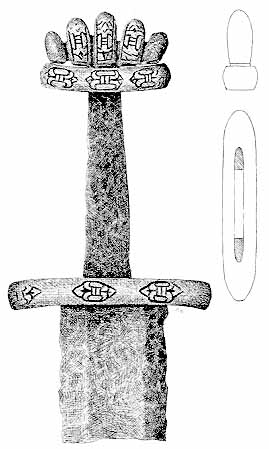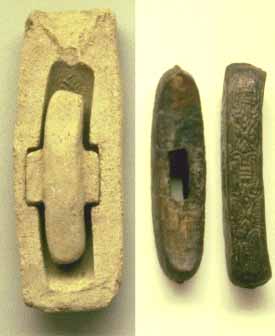

 This (above) inverted boat-profile crossguard (or lower guard) of cast
bronze with incised appearing knot-like ornamentation is characteristic
of the Petersen (1919)
type "O", and the Geibig
(1991) Kombinationstyp 9, associated with the period 900 to 950
by both authors. The illustration of a sword hilt to the left from Petersen
(1919), figure 104, depicts a sword presently in the Universitetet I Oslo
Oldsaksamlingen, accession C.13848a, found at Vestre Berg, Løten,
Hedmark, Norway (a color photograph, frame/item reference 771, of this sword
is on the World of
the Vikings compact disc or laser disc, as is a photograph of another
with a similar bronze hilt from the Tromso Museum, Ts.3592, found at Borge,
Vestvågøy, Nordland, Norway, frame/item reference 5679.) Though
missing from our present example, the upper guard would be expected to also
have been of bronze and to have had five lobes radiating slightly out from
the top of the upper guard.
This (above) inverted boat-profile crossguard (or lower guard) of cast
bronze with incised appearing knot-like ornamentation is characteristic
of the Petersen (1919)
type "O", and the Geibig
(1991) Kombinationstyp 9, associated with the period 900 to 950
by both authors. The illustration of a sword hilt to the left from Petersen
(1919), figure 104, depicts a sword presently in the Universitetet I Oslo
Oldsaksamlingen, accession C.13848a, found at Vestre Berg, Løten,
Hedmark, Norway (a color photograph, frame/item reference 771, of this sword
is on the World of
the Vikings compact disc or laser disc, as is a photograph of another
with a similar bronze hilt from the Tromso Museum, Ts.3592, found at Borge,
Vestvågøy, Nordland, Norway, frame/item reference 5679.) Though
missing from our present example, the upper guard would be expected to also
have been of bronze and to have had five lobes radiating slightly out from
the top of the upper guard.
A loose (that is, without remaining associated blade) cast bronze cross-guard with similar incised knot-like decoration (but with five hairpin-turnbacks between the complex ornaments instead of eight) was found in what is now northern Germany, just south of the present Danish border, in Sierksdorf, and is presented in Geibig (1991) as catalog number 317 (table 161, #8).
Even more intriguing is a small upper guard (with three hairpin-turnbacks
between the knot motifs) found in Haddebyer Noor, accession 13018 in the
Wikinger Museum Haithabu (just outside of Schleswig, Germany), and located
in case 11.4  which explains and illustrates casting techniques (see
an edited photo of the relevant part of this exhibit to the right and below;
I presume the mold and one of the castings are replications), and illustrated
in Geibig (1991)
as catalog number 274 (table 155, #4) and in Geibig (1989) as sword #21 (table 2, #11). This was
found as an isolated artifact retaining flanges from the casting process
where the two halves of the mold joined, that is, appearing never to have
been been finished with a file. This suggests that this hilt component was
never mounted on a sword and is either an incomplete fabrication never finished
or an abandoned flawed casting which escaped recycling. Geibig (1989) notes (p. 257 - 258) that more swords
and sword hilt parts have been found at Hedeby than at the sites of other
costal trading centers of the Viking Age and postulates that the presence
of numerous unfinished objects and isolated hilt parts at this site suggests
that craftsmen here likely produced hilts and mounted hilts of diverse origins
upon sword blades. Thus, on the basis of this evidence, one may wish to
speculate that the present sword was refurbished at Hedeby in the first
half of the 10th Century.
which explains and illustrates casting techniques (see
an edited photo of the relevant part of this exhibit to the right and below;
I presume the mold and one of the castings are replications), and illustrated
in Geibig (1991)
as catalog number 274 (table 155, #4) and in Geibig (1989) as sword #21 (table 2, #11). This was
found as an isolated artifact retaining flanges from the casting process
where the two halves of the mold joined, that is, appearing never to have
been been finished with a file. This suggests that this hilt component was
never mounted on a sword and is either an incomplete fabrication never finished
or an abandoned flawed casting which escaped recycling. Geibig (1989) notes (p. 257 - 258) that more swords
and sword hilt parts have been found at Hedeby than at the sites of other
costal trading centers of the Viking Age and postulates that the presence
of numerous unfinished objects and isolated hilt parts at this site suggests
that craftsmen here likely produced hilts and mounted hilts of diverse origins
upon sword blades. Thus, on the basis of this evidence, one may wish to
speculate that the present sword was refurbished at Hedeby in the first
half of the 10th Century.